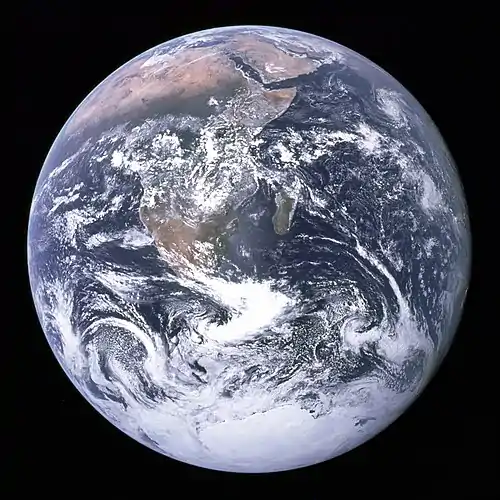Portal:Environment
| Portal | WikiProject Environment | Talk page |
Introduction Land management has preserved the natural characteristics of Hopetoun Falls, Australia while allowing ample access for visitors. The natural environment or natural world encompasses all living and non-living things occurring naturally, meaning in this case not artificial. The term is most often applied to the Earth or some parts of Earth. This environment encompasses the interaction of all living species, climate, weather and natural resources that affect human survival and economic activity. The concept of the natural environment can be distinguished as components:
In contrast to the natural environment is the built environment. Built environments are where humans have fundamentally transformed landscapes such as urban settings and agricultural land conversion, the natural environment is greatly changed into a simplified human environment. Even acts which seem less extreme, such as building a mud hut or a photovoltaic system in the desert, the modified environment becomes an artificial one. Though many animals build things to provide a better environment for themselves, they are not human, hence beaver dams, and the works of mound-building termites, are thought of as natural. (Full article...) A biophysical environment is a biotic and abiotic surrounding of an organism or population, and consequently includes the factors that have an influence in their survival, development, and evolution. A biophysical environment can vary in scale from microscopic to global in extent. It can also be subdivided according to its attributes. Examples include the marine environment, the atmospheric environment and the terrestrial environment. The number of biophysical environments is countless, given that each living organism has its own environment. The term environment can refer to a singular global environment in relation to humanity, or a local biophysical environment, e.g. the UK's Environment Agency. (Full article...) Selected article -The environmental impacts of animal agriculture vary because of the wide variety of agricultural practices employed around the world. Despite this, all agricultural practices have been found to have a variety of effects on the environment to some extent. Animal agriculture, in particular meat production, can cause pollution, greenhouse gas emissions, biodiversity loss, disease, and significant consumption of land, food, and water. Meat is obtained through a variety of methods, including organic farming, free range farming, intensive livestock production and subsistence agriculture. The livestock sector also includes wool, and egg and dairy production, the livestock used for tillage, and fish farming. Animal agriculture is a significant contributor to greenhouse gas emissions. Cows, sheep and other ruminants digest their food by enteric fermentation, and their burps are the main methane emissions from land use, land-use change, and forestry: together with methane and nitrous oxide from manure this makes livestock the main source of greenhouse gas emissions from agriculture. A significant reduction in meat consumption is essential to mitigate climate change, especially as the human population increases by a projected 2.3 billion by the middle of the century. (Full article...)Did you know (auto-generated) -
Selected image - a bison skull pile, ca 1870. A pile of bison skulls (circa 1870). The North American bison were hunted almost to extinction in the 19th century and were reduced to very small numbers by the mid-1880s.
Current eventsNews
Selected biography -
David Takayoshi Suzuki CC OBC FRSC (born March 24, 1936) is a Canadian academic, science broadcaster, and environmental activist. Suzuki earned a PhD in zoology from the University of Chicago in 1961, and was a professor in the genetics department at the University of British Columbia from 1963 until his retirement in 2001. Since the mid-1970s, Suzuki has been known for his television and radio series, documentaries and books about nature and the environment. He is best known as host and narrator of the popular and long-running CBC Television science program The Nature of Things, seen in over 40 countries. He is also well known for criticizing governments for their lack of action to protect the environment. A longtime activist to reverse global climate change, Suzuki co-founded the David Suzuki Foundation in 1990, to work "to find ways for society to live in balance with the natural world that does sustain us." The Foundation's priorities are: oceans and sustainable fishing, climate change and clean energy, sustainability, and Suzuki's Nature Challenge. The Foundation also works on ways to help protect the oceans from large oil spills such as the Deepwater Horizon oil spill. Suzuki has also served as a director of the Canadian Civil Liberties Association from 1982 to 1987. (Full article...)Selected organization -
The International Geosphere-Biosphere Programme (IGBP) was a research programme that ran from 1987 to 2015 dedicated to studying the phenomenon of global change. Its primary focus was coordinating "international research on global-scale and regional-scale interactions between Earth's biological, chemical and physical processes and their interactions with human systems." The International Council of Scientific Unions, a coordinating body of national science organizations, launched IGBP. It looked at the total Earth system, the changes that are occurring, and the manner in which changes are influenced by human actions. (Full article...)General images -The following are images from various environment-related articles on Wikipedia.
Selected quote -More did you know -
 Incandescent light bulb
Main topicsRelated articlesThings you can do
Related categories
Related portalsWikiProjects
Associated WikimediaThe following Wikimedia Foundation sister projects provide more on this subject:
Discover Wikipedia using portals
| ||||||||||||







.jpg.webp)





.jpg.webp)


_peeking_from_a_leaf_hole_of_an_Alnus_nepalensis_tree_(cropped).jpg.webp)

.jpg.webp)

.jpg.webp)


.jpg.webp)















_18.jpg.webp)












.JPG.webp)


.jpg.webp)


.jpg.webp)








